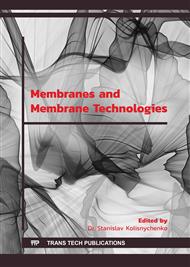[1]
B. V. D. Bruggen, C. Vandecasteele, T. V. Gestel, W. Doyen, R. Leysen, A review of pressure-driven membrane processes in waste water treatment and drinking water production, Environ. Progress. 22 (2003) 46–56.
DOI: 10.1002/ep.670220116
Google Scholar
[2]
X. Lu, X. Bian, L. Shi, Preparation and characterization of NF composite membrane, J. Membr. Sci. 210 (2002) 3-11.
Google Scholar
[3]
B. Van der Bruggen, C. Vandecasteele, Removal of pollutants from surface water and groundwater by nanofiltration: overview of possible applications in drinking water industry. Env. Poll. 122 (2003) 435-445.
DOI: 10.1016/s0269-7491(02)00308-1
Google Scholar
[4]
H. D. M. Sombekke, D. K. Voorhoeve, P. Hiemstra, Environmental impact assessment of groundwater treatment with nanofiltration, Desalination 113 (1997) 293–296.
DOI: 10.1016/s0011-9164(97)00144-6
Google Scholar
[5]
C. Visvanathan, B. D. Marsono, B. Basu, Removal of THMP by nanofiltration: Effects of interference parameters, Water Res. 32 (1998) 3527–3538.
DOI: 10.1016/s0043-1354(98)00151-1
Google Scholar
[6]
B. B. Levine, K. Madireddi, V. Lazarova, M.K. Stentrom, M. Suffet, Treatment of trace organic compounds by membrane processes: At the Lake Arrowhead water reuse pilot plant, Water Sci. Technol. 40 (199) 293–301.
DOI: 10.2166/wst.1999.0603
Google Scholar
[7]
Y. Kiso, Y. Nishimura, T. Kitao, K. Nishimura, Rejection properties of non- phenylic pesticides with nanofiltration membranes, J. Membr. Sci. 171 (2000) 229–237.
DOI: 10.1016/s0376-7388(00)00305-7
Google Scholar
[8]
T. H. Liu, K.M. Simms, S.A. Zaidi, Selection of ultrafiltration nanofiltration membrane for treatment of textile effluent of textile dyeing wastewater, Water Treatment 9 (1994) 189–198.
Google Scholar
[9]
D. Trebouet, J.P. Schlumpf, P. Jaouen, J.P. Maleriat, F. Quemeneur, Effect of operating conditions on the nanofiltration of landfill leachates: Pilot-scale studies, Environ. Technol. 20 (1999) 587–596.
DOI: 10.1080/09593332008616853
Google Scholar
[10]
A.G. Fane, P. Macintosh, G. Leslie, Water reclamation, remediation and cleaner production with nanofiltration. In A. I. Schafer, A.G. Fane,T. D. Waite (Eds. ), Nanofiltration Principles and Applications, Chapter 11 Elsevier, Oxford, (2005).
Google Scholar
[11]
Z. B. Gonder, S. Arayici, H. Barlas, Advanced treatment of pulp and paper mill wastewater by nanofiltration process: Effects of operating conditions on membrane fouling, Separation and Purification Technology 76 (2011) 292-302.
DOI: 10.1016/j.seppur.2010.10.018
Google Scholar
[12]
A. Cassano, R. Molinari,M. Romano,E. Drioli, Treatment ofaqueouseffluents of the leather industry by membrane processes- A review, J. Membr. Sci. 181 (2001) 111-126.
DOI: 10.1016/s0376-7388(00)00399-9
Google Scholar
[13]
R. Kettunen, P. Keskitalo, Combination of membrane technology and limestone filtration to control drinking water quality, Desalination 131 (2000) 271-283.
DOI: 10.1016/s0011-9164(00)90025-0
Google Scholar
[14]
O. Raff, R. D. Wilken, Removal of dissolved uranium by nanofiltration, Desalination 22 (1999) 147-150.
DOI: 10.1016/s0011-9164(99)00035-1
Google Scholar
[15]
M. Al-Sofi, A. Hassan, G. Mustafa, A. Dalvi, M. Kither, Nanofiltration as a means of achieving higher TBT of ≥ 120°C in MSF, Desalination. 118 (1998) 123-129.
DOI: 10.1016/s0011-9164(98)00106-4
Google Scholar
[16]
W. Richard Baker, Membrane technology and applications John Wiley & Sons Ltd, The Atrium, Southern Gate, Chichester, West Sussex PO19 8SQ, England. (2004).
DOI: 10.1111/1471-0307.12074
Google Scholar
[17]
M. Padaki, A.M. Isloor, B. Ganesh, N. Prabhu, Preparation, characterization and performance study of Poly (isobutylene-alt-maleic anhydride) [PIAM] and Polysulfone [PSf] composite membranes before and after alkali treatment, Ind. Eng. Chem. Res. 50 (2011).
DOI: 10.1021/ie102387n
Google Scholar
[18]
C. Hegde, M. Padaki, A.M. Isloor, P. Wanichapichart, L. Yu, Synthesis and desalination performance of Ar+-N+ irradiated polysulfone based new NF membrane, Desalination 265 (2011) 153-158.
DOI: 10.1016/j.desal.2010.07.046
Google Scholar
[19]
M. Helen, B. Viswanathan, S. Srinivasa Murthy, Synthesis and characterization of composite membranes based on-zirconium phosphate and silicotungstic acid, J. Membr. Sci. 292 (2007) 98-105.
DOI: 10.1016/j.memsci.2007.01.018
Google Scholar
[20]
M. Masuelli, J. Marchese, N. A. Ochoa, SPC/ PVDF membranes for emulsified oily wastewater treatment, J. Membr. Sci. 326 (2009) 688-693.
DOI: 10.1016/j.memsci.2008.11.011
Google Scholar
[21]
M. J. Rosa, M. N. de Pinho, Membrane surface characterisation by contact angle measurements using the immersed method, J. Membr. Sci. 131 (1997) 167-180.
DOI: 10.1016/s0376-7388(97)00043-4
Google Scholar
[22]
W. Cuihttp: /www. sciencedirect. com/science/article/pii/S1383586698000690 - implicit0, J. Kerres, G. Eigenberger, Development and characterization of ion-exchange polymer blend membranes, Separation and Purification Technology 14 (1998) 145-154.
DOI: 10.1016/s1383-5866(98)00069-0
Google Scholar
[23]
T. Toshinori, O. Kazuhisa, K. Masakoto, Y. Tomohisa, Permeation characteristics of electrolytes and neutral solutes through titania nanofiltration membranes at high temperatures, Langmuir 26 (2010) 10897-10905.
DOI: 10.1021/la100791j
Google Scholar
[24]
M. Manttari, A. Pihlajamaki, M. Nystom, Effect of pH on hydrophilicity and charge and their effect on the filtration efficiency of NF membranes at different pH, J. Membr. Sci. 280 (2006) 311-320.
DOI: 10.1016/j.memsci.2006.01.034
Google Scholar
[25]
A. Seidel, J. J. Waypa, M. Elimelech, Role of charge (Donnan) exclusion in removal of arsenic from water by a negatively charged porous nanofiltration membrane. Environ. Eng. Sci. 18 (2001) 105-113.
DOI: 10.1089/10928750151132311
Google Scholar
[26]
A. Orecki, M. Tomaszewska, K. Karakulski, A.W. Morawski, Surface water treatment by the nanofiltration method, Desalination 2004, 162, 47-54.
DOI: 10.1016/s0011-9164(04)00026-8
Google Scholar



